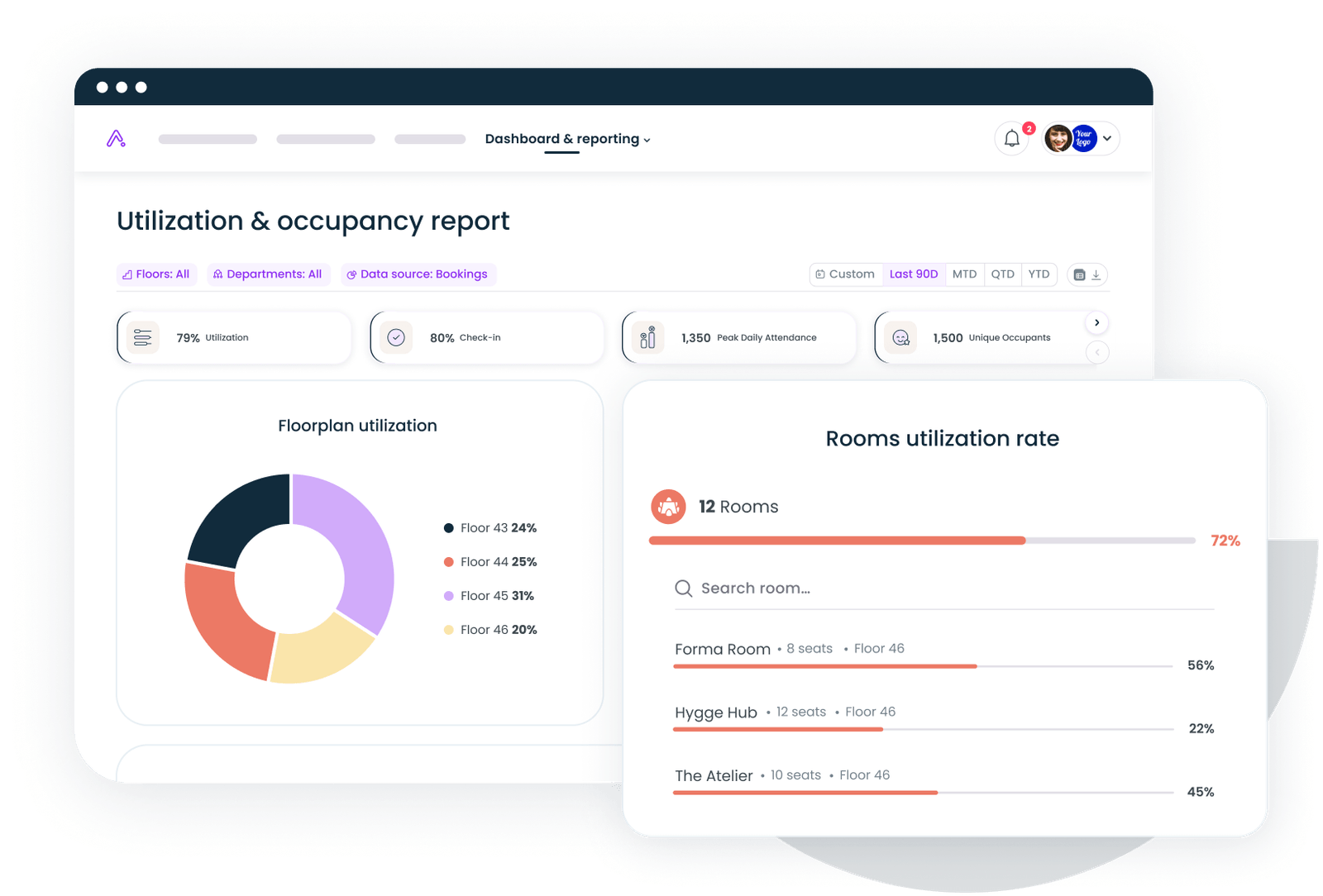Your office sits half-empty most days. You're paying for 200 desks when only 80 people show up. Sound familiar?
The percentage of dedicated desks dropped from 51% in 2021 to just 40% in 2024, and 62% of employers now use flexible desk-sharing models. The shift isn't coming; it's already here.
The difference between success and failure? Implementation. Companies that remove assigned seating without a booking system, clear policies, or a collaboration plan end up with frustrated employees who can't find desks. But companies that approach desk sharing strategically see major cost savings alongside better employee experiences.
This guide shows you exactly how to do it right: implementing desk sharing as a core part of your hybrid work strategy, complete with the systems, policies, and practices that actually work.
What is desk sharing?
Desk sharing is a flexible workplace arrangement where employees don't have permanently assigned workstations. Instead, they book desks ahead of time when they need to work in the office. Once they leave, that same space becomes available to the next person.
This system matches desk availability to office attendance rather than maintaining empty desks for people working remotely. Desk sharing comes in several forms: hot desking, where employees choose any available desk when they arrive, desk hoteling, which requires advance reservations through a desk booking system, and activity-based working, where different zones support specific work types.
The shift toward shared desks reflects a simple reality: office space is left unused for about one-third of the working day, creating a financial drain for companies paying premium real estate costs.
Benefits of desk sharing
Reduced real estate costs
The financial impact of desk sharing shows up immediately in your bottom line. Companies save 30-40% on real estate expenses by optimizing their employee-to-desk ratio. Rather than maintaining a 1:1 setup, organizations now target ratios between 1.01 and 2.0 employees per desk.
When 40% of office space sits empty, you're paying rent for unused space. Lower square footage means reduced overhead costs for utilities, cleaning, office furniture, and maintenance - savings you can redirect toward better technology and enhanced collaboration spaces.
Better space utilization
Desk sharing transforms underutilized real estate into a functional workspace. Shared desk environments keep workstations available for whoever needs them, rather than leaving them empty while employees work remotely.
This enables smarter office layout decisions; dedicating more space to meeting rooms, collaboration areas, and designated spaces that support different work activities creates better employee experiences than rows of assigned desks.
Increased flexibility for hybrid teams
Desk sharing gives hybrid workers autonomy to choose where they work based on daily needs. Someone needs a quiet zone on Monday, a collaborative spot near teammates on Tuesday, and a standing desk on Wednesday - desk sharing makes that possible.
Teams can reserve adjacent desks for in-person collaboration, then work remotely during focus periods, creating more meaningful office time than forcing everyone into assigned desks.
Enhanced collaboration opportunities
Shared desks break down the physical silos often found in traditional office spaces. When employees aren't confined to permanent seating, they naturally interact with team members from different teams.
Office neighborhoods provide enough structure for teams to find each other while maintaining the flexibility that makes shared workspace valuable.

See how workplace leaders are implementing desk sharing at scale. Read our guide on companies that reduced real estate costs by 30% while improving employee satisfaction with data-driven strategies.
Read more
Challenges of desk sharing
Lack of personalization and personal space
The absence of a personal desk eliminates the ability to customize workspaces with personal belongings. This loss of personal space can reduce their sense of belonging. The solution isn't abandoning desk sharing but providing lockers or secure storage for personal items and work materials.
Cleanliness and hygiene concerns
Shared desks amplify hygiene concerns without clear desk-sharing rules. Companies need to provide cleaning supplies—sanitizers, antibacterial wipes, and disposal options—at every workstation. A desk-sharing policy requiring employees to wipe surfaces, remove all personal belongings, and reset furniture before leaving ensures the next person arrives at a clean desk space.
Technology and equipment coordination
When employees move between desks daily, they need to bring their own devices or rely on standardized equipment. A BYOD approach works well—employees use their own devices and plug into monitors at any available desk —but it requires robust wireless infrastructure and secure cloud space for shared documents. For roles requiring specialized equipment, desk booking software should let employees reserve desks with specific amenities, such as dual monitors.
Finding available desks
Without a reliable reservation system, employees waste time searching for open workstations. Modern desk booking software lets employees see real-time availability, reserve desks in advance, and even book meeting rooms alongside their workstations. The certainty that a desk awaits them removes friction and makes office days productive from the moment of arrival.
Gable Offices makes it simple for employees to book desks & meeting rooms while providing real-time data on how your space is being used. Use Gable to optimize your hybrid office and reduce real estate costs.
Learn more
Best practices and shared desk etiquette
Implement a robust desk reservation system
A desk booking system forms the foundation of successful desk sharing. Employees need visibility into available desks, reservation capabilities, and confidence their booking will be honored. The best systems integrate with Slack, Microsoft Teams, Google Calendar, or mobile apps where employees already manage schedules. Choose software that provides analytics alongside reservations - Gable's Office Management solution combines intuitive desk booking with real-time insights into how your spaces are actually used.
Create clear desk-sharing policies
Written guidelines eliminate confusion in a shared desk environment. Your desk-sharing policy should cover reservation procedures, cancellation requirements, and the consequences for violations. Address practical details: when employees must clean their workspaces, where to store shared documents, and whether to use soundproof phone booths for confidential data discussions.
Designate different workspace types
Your shared desk system should accommodate different activity needs. Create distinct zones for focused work, team meetings, phone calls, and brainstorming sessions.
This activity-based approach helps employees self-select appropriate spaces—someone on a video call uses a desk in a designated area rather than disrupting colleagues who need a completely silent environment.
Provide adequate storage solutions
Personal belongings and private belongings need secure storage when desks aren't permanently assigned. Lockers reduce the pack-in, pack-out burden. Storage should accommodate laptops, notebooks, charging cables, and personal items. Consider tiered options - some employees need minimal storage while others working on-site multiple days need more capacity.
Maintain ergonomic furniture options
Provide ergonomic furniture that employees can adjust, including adjustable-height desks, chairs with customizable lumbar support, and monitor arms. These seating options matter for employee well-being and job satisfaction. When people have different preferences, adjustable equipment lets each person configure their temporary workspace to their liking.
Enable seamless technology integration
Every workstation needs reliable power access, high-speed internet, and plug-and-play capability. Standardize your setup across desks—consistent monitor connections and peripheral access create predictable experiences. While some roles require Ethernet, eliminating unnecessary cables makes the flexible office space feel more open.
Establish cleaning and reset procedures
Every shared desk should return to a neutral state between users. Implement cleanup checklists: wipe surfaces, dispose of trash, reset furniture, disconnect personal devices, and remove all personal items. Make disinfectant wipes, hand sanitizer, and trash receptacles easily accessible. Eliminating barriers increases compliance with desk-sharing rules.
Communicate benefits and gather feedback
Explain how shared models enable cost savings reinvested in better amenities for remote working. Survey employees about their experience and use pulse surveys to track job satisfaction and employee concerns. This employee feedback drives continuous improvement.
Share utilization reports demonstrating peak attendance days; these valuable insights help the entire company make better decisions about implementing hot desking and build trust in the desk-sharing system and the company's culture around flexible work.
With Gable, you can implement desk booking, optimize space utilization, and gather the data you need to make smart real estate decisions. See how leading companies are transforming their hybrid workplaces.
Get a demo





.svg)





.svg)
















.svg)













